How to Make Balsamic Glaze
A simple and easy tutorial on how to make balsamic glaze at home! Tangy and slightly sweet, this delicious condiment is perfect for drizzling on anything you can think up. And with no added sugar, it’s so much cheaper than store-bought. Gluten free and vegan.
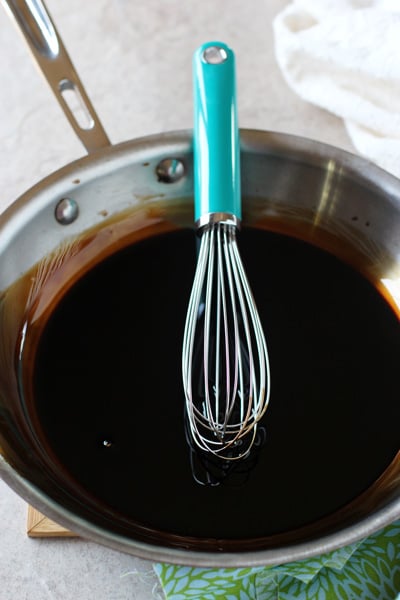
What better way to kick off a Wednesday than with the tangy, slightly sweet goodness that is balsamic glaze ♥
This post has been a longggg time coming. Months ago – we’re talking like back in August – one of my readers pointed out that I reference balsamic glaze quite a bit on my site but never shared my actual recipe / method for making it!
For those of you who have been reading for some time, you know that my love for this magical goodness is well documented. I’ll drizzle it on anything and everything. Well, where it makes sense. I do try to have some self-control.
And man, if you buy balsamic glaze from the store it will cost you an arm and a leg. I’m pretty sure I’ve seen bottles of it for well over $10. Madness.
Especially considering you can make it at home for way way less. All you need is some balsamic vinegar and a skillet. And considering what a cheap-o I can be with certain things, making it at home is the way. to. go.
Save that money for something else.
But back to the glaze. Let’s quickly walk through the process (the full, detailed recipe is below as usual).
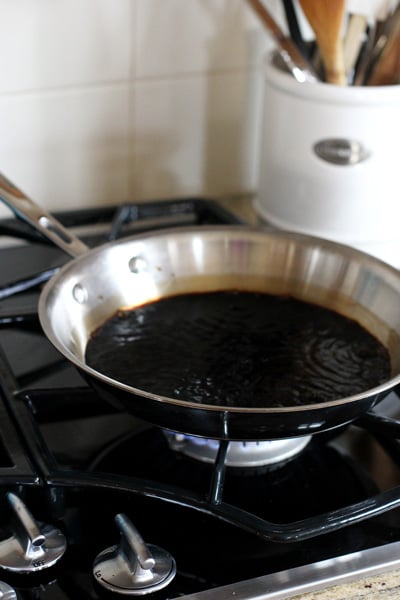
How To Make Balsamic Glaze
So, we pour some balsamic vinegar into a skillet and allow it to come to a very gentle simmer.
Then we turn down the heat and basically let it cook until it reduces down by about two-thirds to three-quarters.
During this time, you NEED to whisk every few minutes, and slightly more often towards the end of the process.

And please, do not walk away while you are making this! The vinegar can burn easily and well, the resulting mess ain’t pretty. So just be prepared to hang out nearby.
I know a lot of people add some sugar to their balsamic glaze, but I’ve never really found it necessary. It gets sort of sweet on its own as it reduces and cooks down.
When it’s done, the reduction should coat the back of a spoon like in the photo below.
Ahhh, that’s the good stuff right there.
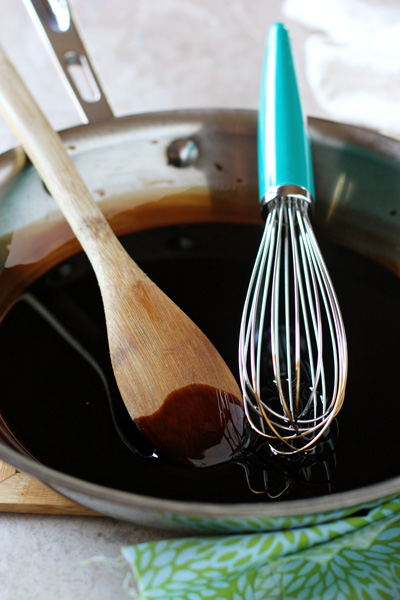
Additional DIY Recipes You Might Enjoy:
- How To Set Up A DIY Mimosa Bar
- Homemade Peanut Sauce
- Spiced Sugared Cranberries
- Homemade Enchilada Sauce
- Dairy Free Sour Cream
Did you make this recipe? Rate and review it down below! I’d love to hear from you.
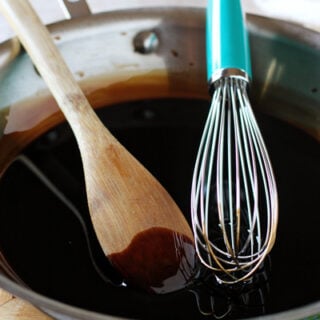
How to Make Balsamic Glaze
A simple and easy tutorial on how to make balsamic glaze at home! Tangy and slightly sweet, this delicious condiment is perfect for drizzling on anything you can think up. And with no added sugar, it’s so much cheaper than store-bought. Gluten free and vegan.
Ingredients
- 1 cup balsamic vinegar*
Instructions
- Add the balsamic vinegar to a medium skillet set over medium / medium-high heat. Allow the vinegar to come to a very gentle simmer, then turn down the heat to medium-low, or so it is steaming and just barely simmering (a few bubbles here and there).
- Let the vinegar cook, whisking every few minutes, until it has reduced down by about ⅔ to ¾. Toward the end of the cooking time, you’ll want to whisk more often to keep it from burning and may need to turn down the heat. This takes me anywhere from about 15 to 25 minutes.
- DO NOT walk away during this process. The vinegar can burn easily, especially at the end of the cooking process. And no one wants a burnt mess to deal with.
- Once reduced, remove from the heat and let cool completely. It will thicken even more as it cools. Store in an airtight container in the fridge. You can let it come back to room temp before using, if desired.
Notes
*Feel free to use whatever amount of vinegar you like, keeping in mind that it will reduce down by about ⅔ to ¾.
Some people do add sugar to their glaze, but I’ve never found it necessary.
I like to use a skillet when making this because I find that when I use a regular saucepan some of the vinegar can almost get “stuck” and burn in the edges of the pan - the skillet gets rid of that problem.
Also, turn on your vent! It helps get rid of some of those vinegar fumes - which are potent.
Nutrition Information:
Yield: 6 Serving Size: 1Amount Per Serving: Calories: 37Total Fat: 0gSaturated Fat: 0gTrans Fat: 0gUnsaturated Fat: 0gCholesterol: 0mgSodium: 10mgCarbohydrates: 7gFiber: 0gSugar: 6gProtein: 0g
Nutrition data shown is an estimate provided by an online calculator and is for informational purposes only. It should not be considered a substitute for a medical professional’s advice.

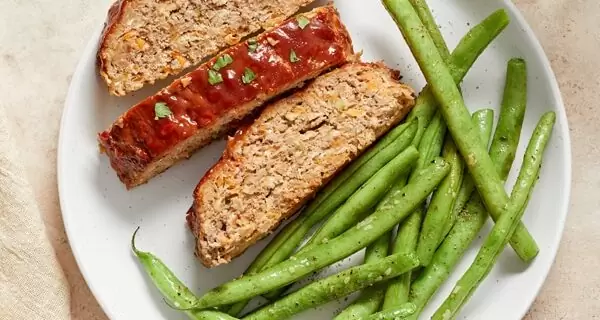
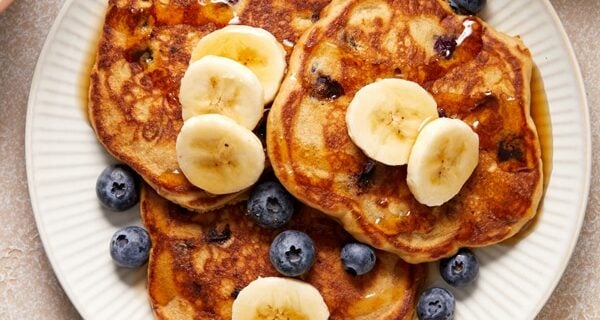
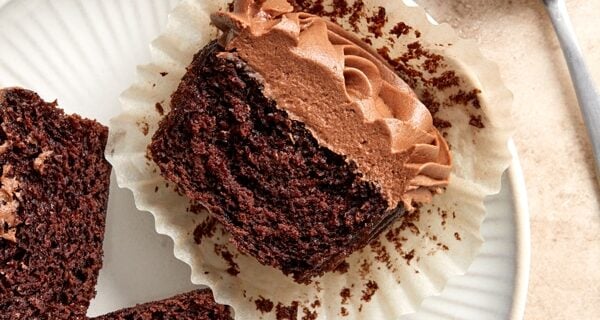
Oh wow – I would never have thought Balsamic glaze was balsamic vinegar reduced down – thanks for this, Ashley!
This looks absolutely amazing! I love those balsamic vinegar, and I love your creativity! I’ve never known how to do this and now I do 🙂 Do you think you could ship some to me by any chance? 😉
haha done!
Oh I love this stuff! I never thought to make glaze at home, its a great idea. While the vinegar is an ok price the glaze is super expensive. I shall definitely give this a go, thanks for a great tip.
Balsamic glaze is great for so many things! Love the tutorial!
I must give this a try soon! So easy and fun.
Wow, what a great tutorial, Ashley! I don’t think it has ever occurred to me to make a homemade version of this, but I’m glad you did! I love your comment about turning on the vent, haha. Hope switching your hosting went well! 🙂
haha the fumes are so potent!!!! 🙂
Oh my!!! I’m so glad you finally shared this! Can’t wait to give this a whirl.
One of my very favorite things!! Yum. Love the pics!
Thanks for the recipe Ashley…much easier than I thought…I love the glaze in chicken and steaks…yum!
Enjoy the rest of your week 🙂
I LOVE balsamic glaze, and it’s so easy to make, there’s almost no excuse not to! Great tutorial. 🙂
Lovely pictures and great tutorial 🙂
Ok, this is genius, i’m absolutely in love with balsamic glaze but am now wondering why I haven’t made it at home. Totally pinning!
I didn’t know you could do this without a sugar. I love love love balsamic glaze… it goes with everything!
Yes! It’s not quite as sweet as the store-bought stuff but it definitely still sweetens up!
Love this tutorial, I would find every excuse to drizzle that on everything! Good luck with the switch 🙂
I just used store bought balsamic glaze on a panini for dinner tonight! Haha. Isn’t it the best drizzled over crostini topped with olive oil, tomato, basil & mozzarella? Yum!
I want to drizzle that goodness on everyTHANG!
I adore balsamic on pretty much everything, so this glaze looks amazing! Awesome how-to post Ashley! 😀
Thanks Jess!
Good luck with the switch!
I love the step by step instructions! Looks amazing!
You are so right about not adding sugar. This glaze looks delectable 🙂
YAY! Totally adoring this post, Ashley! also … I need that multi-colored whisk in my life … like now.
haha yeah, I’m obsessed with that one! I’m pretty sure I got it at Sur la Table!
Balsamic glaze is a flavorful addition to so many meals. Thanks for sharing! Good luck with the change to the host, I am doing the same thing early next week. Hopefully everything goes smooth.
Firstly, you have the prettiest whisks!! So colorful! Secondly, I love balsamic glaze and like to put it on pretty much everything! I fell victim to buying it once and it really was so expensive and I think it had a lot of added sugar to it too. I can’t think of so many things I want to drizzle this beautiful sauce all over 🙂
Thank you!! I own wayyy too many 🙂 Yup, the store-bought ones definitely have a bunch of sugar! It’s nice to be able to control that at home!
Such a great idea to make your own balsamic glaze! I can think of lots of things to use it for. 🙂
I absolutely love balsamic vinegar, so I know I would be able to devour this by the spoonful!
I love balsamic glaze on chicken, but I must admit, I always buy it. I am going to try making it myself – great tutorial!
Thanks Dannii!
I tried to make balsamic glaze a few years ago and burned it. It got all caked on the pan I decided to never make it again, lol. I’ll have to give it another go, though!
haha yeahhhh that happened to me once when I was trying to do other things at the same time … it wasn’t pretty!!
Love this tutorial, Ashley! Like caramelized onions, this is the kind of thing to have in our arsenal that really amps up our food. : ) I suppose you can keep it a very long time in the fridge, too? Love it!
Agreed! 🙂 Yes! I’ve had a few batches in the fridge for at least a few weeks now and they still seem completely fine to me!
I always contemplate balsamic glaze at the store, but the price scares me away! I love how simple this is. I mean, one ingredient? Yes!
This post was clearly meant for my husband. The guy drinks balsamic glaze by the gallon. And what a great way to save a few $$$. Love all the whisks in this post ~ way too cute!!
haha thanks Laura! I have a little problem with colorful whisks 🙂
This is a great tutorial Ashley! I hope everything is going okay as you’ve switched hosting companies – I’ve done that and it’s no simple process!!
Thanks Chelsea! Oh my gosh – what a process!!! But at least it’s pretty much done at this point!
I’m so glad you shared this, Ashley! I’ve never actually made my own glaze before, but absolutely love it. And I’m so happy to see how easy this is! Pinning!
It’s super easy! You just have to pay attention! haha learned that the hard way 🙂